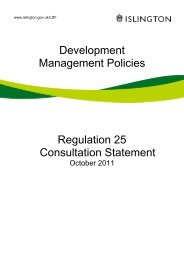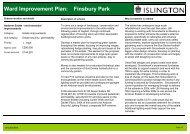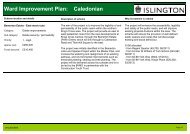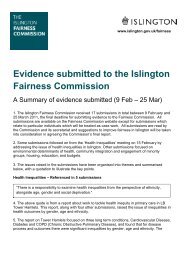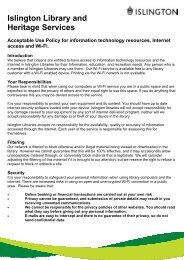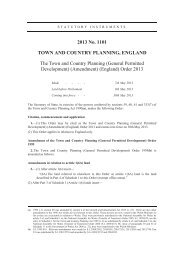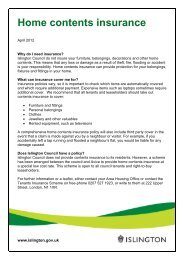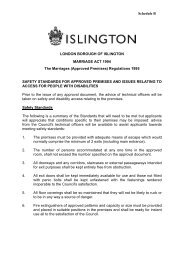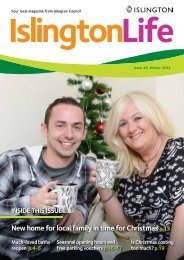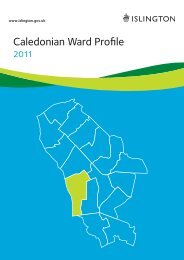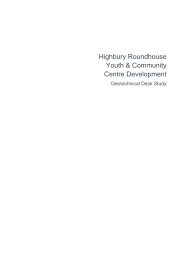Two Islingtons: Understanding the Problem - Islington Council
Two Islingtons: Understanding the Problem - Islington Council
Two Islingtons: Understanding the Problem - Islington Council
You also want an ePaper? Increase the reach of your titles
YUMPU automatically turns print PDFs into web optimized ePapers that Google loves.
5. Tackling Housing Inequalities<br />
5.1. There are significant inequalities between residents in regards to access to and <strong>the</strong><br />
provision of affordable housing and decent housing within <strong>the</strong> borough. More women than<br />
men live in non-decent / social housing. Older disabled people and those suffering from<br />
long-term physical & mental health problems are more likely to have a lack of housing or<br />
inadequate / poor quality housing and 40% of children live in overcrowded unfit housing.<br />
Housing inequalities are significantly impacted upon by <strong>the</strong> availability of affordable<br />
housing in <strong>the</strong> borough and severe over-crowding issues.<br />
5.2. <strong>Islington</strong> has a high level of social housing, and a high level of inequality and <strong>the</strong>se two<br />
facts are almost certainly correlated. The John Hills report ‘Ends and means: <strong>the</strong> future<br />
roles of social housing in England’ (2007) states that tenants are more likely to have low<br />
incomes and not be in employment compared to those in o<strong>the</strong>r tenures. Nationally 70% of<br />
social tenants have incomes within <strong>the</strong> poorest two fifths of overall income distribution and<br />
<strong>the</strong> proportion of social tenant households in paid employment fell from 47% to 32%<br />
between 1981 and 2006. Tenants also have high rates of disabilities and are more likely<br />
than o<strong>the</strong>rs to be lone parents, single people and be over 60. Additionally, more than a<br />
quarter of BME household are social tenants.<br />
5.3. Reducing overcrowding: Overcrowding officers have been dealing with <strong>the</strong> housing<br />
queries raised by <strong>the</strong> door knocking initiatives in <strong>the</strong> borough such as ‘Help on your<br />
doorstep’, ‘<strong>the</strong> Canonbury Project’ and ‘EC1 New Deal’. Six tenants have taken up <strong>the</strong><br />
‘Time Out’ scheme and moved into private sector homes suitable for <strong>the</strong>ir needs. An<br />
additional 15 families have been helped with space saving furniture to mitigate <strong>the</strong> affects<br />
of living in an overcrowded home while <strong>the</strong>y wait for a housing transfer. The annual target<br />
to assist 160 severely overcrowded households has been met with 278 households<br />
assisted in 2009-10. Of those applicants within <strong>the</strong> third quarter of 2009-10 <strong>the</strong> majority<br />
came from <strong>the</strong> under 16 age group and from White British or Black African households.<br />
5.4. Homelessness: A number of projects are in place to tackle homelessness within <strong>the</strong><br />
borough. Work has been undertaken to address <strong>the</strong> findings of <strong>the</strong> Black Homelessness<br />
study of December 2007. Workshops were held with <strong>the</strong> voluntary sector to see how <strong>the</strong><br />
findings could be taken forward and as a result a number of internal processes and<br />
procedures were revised such as establishing an email alert system to advise on changes<br />
in policies and legislation with regard to housing and homelessness issues. Additionally<br />
<strong>the</strong> Homelessness Forum progresses issues within <strong>the</strong> borough. During April-Jan 2009/10<br />
569 residents were prevented from becoming homeless and 53 unsuccessfully prevented.<br />
Since 2006-07 <strong>the</strong> numbers of residents accepted as homeless and in priority need per<br />
10000 households has significantly decreased within <strong>the</strong> borough (from 2.0 to 0.7) and is<br />
now on a par with London, although higher than <strong>the</strong> England figure.<br />
5.5. The Home Shelter Sanctuary Scheme offers <strong>the</strong> victims of domestic violence <strong>the</strong> option<br />
of remaining in <strong>the</strong>ir home as an alternative to making an application for emergency<br />
housing assistance. The scheme is a partnership between <strong>the</strong> <strong>Council</strong>, <strong>the</strong> Police and<br />
Kier; who enable <strong>the</strong> victims of Domestic Violence <strong>the</strong> opportunity to remain in <strong>the</strong>ir home<br />
10



